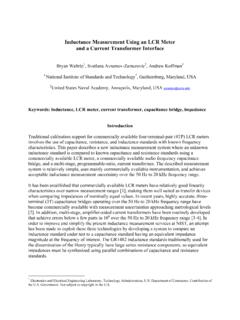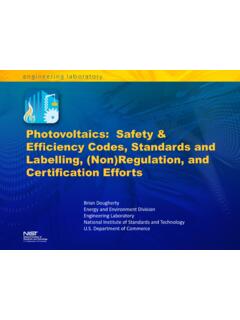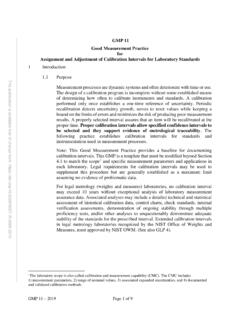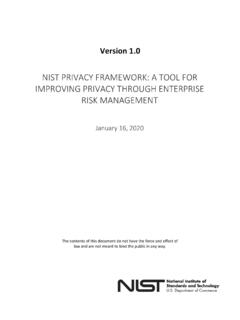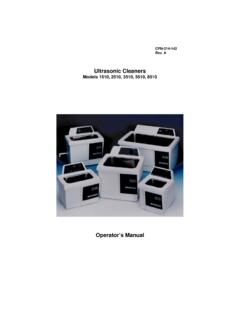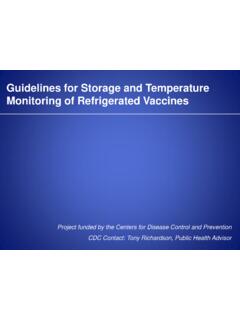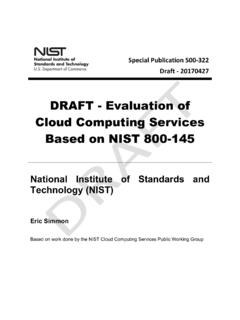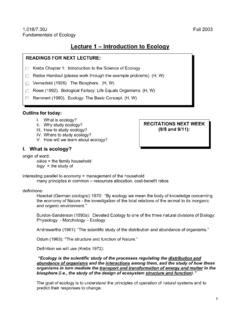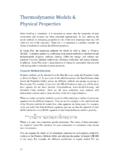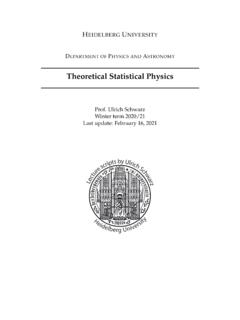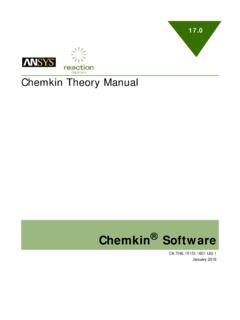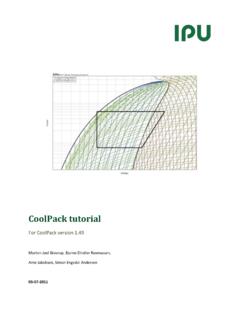Transcription of NIST/ASME Steam Properties—STEAM
1 NIST Standard Reference Database 10. NIST/ASME Steam Properties Steam . Version User's Guide Allan H. Harvey Eric W. Lemmon Applied Chemicals and Materials Division National Institute of Standards and Technology Boulder, Colorado 80305. June 2013. Department of Commerce National Institute of Standards and Technology Standard Reference Data Program Gaithersburg, Maryland 20899. The National Institute of Standards and Technology (NIST) uses its best efforts to deliver a high quality copy of the Database and to verify that the data contained therein have been selected on the basis of sound scientific judgment. However, NIST makes no warranties to that effect, and NIST shall not be liable for any damage that may result from errors or omissions in the Database. 2013 copyright by the Secretary of Commerce on behalf of the United States of America. All rights reserved. No part of this database may be reproduced, stored in a retrieval system, or transmitted, in any form or by any means, electronic, mechanical, photocopying, recording, or otherwise, without the prior written permission of the distributor.
2 Certain trade names and other commercial designations are used in this work for the purpose of clarity. In no case does such identification imply endorsement by the National Institute of Standards and Technology, nor does it imply that the products or services so identified are necessarily the best available for the purpose. Microsoft, Windows, Excel, and Visual Basic are either registered trademarks or trademarks of the Microsoft Corporation in the United States and/or other countries; MATLAB is a trademark of MathWorks. ACKNOWLEDGMENTS. We gratefully acknowledge the many contributions of our colleagues and associates. Dr. Gary Hardin (of NIST) provided support with the help file and the installation package. Previous versions of the Steam . database were developed with significant contributions from Prof. Sanford Klein of the University of Wisconsin and Dr. Adele Peskin of NIST. This database benefits from NIST's REFPROP database, co- authored by Drs.
3 Eric Lemmon, Mark McLinden, and Marcia Huber of NIST; Dr. Huber also contributed the code for calculating viscosity and thermal conductivity. We also benefit from the contributions of Frank Doyle to the debugging of REFPROP and its use in Excel. The scientific formulations for property calculations implemented in this software owe their existence to the efforts of the International Association for the Properties of Water and Steam (IAPWS), and in particular to its Working Group on Thermophysical Properties of Water and Steam . Development of this software package was supported by the NIST Thermophysical Properties Division and the NIST Standard Reference Data Program. CONTENTS. 1. 1. 2. INSTALLATION .. 2. System Requirements .. 2. 3. 3. OVERVIEW .. 3. Database Structure .. 3. Use of the Database .. 3. Overview of the Menus .. 3. Cautions .. 4. 4. GENERATING property TABLES .. 5. Calculating Saturation 5. Calculating Iso- property Tables.
4 6. Calculating Tables at Specified State Points .. 7. Calculating Saturation Properties at Specified Points .. 9. Reformatting Existing Data Tables .. 10. Warnings and Errors .. 10. 5. CREATING AND MODIFYING 12. Plotting Data from Tables .. 12. Overlaying Data onto Existing Plots .. 13. Predefined Diagrams of Thermodynamic Surfaces .. 13. Modifying Plots .. 15. The Modify Plot command .. 15. Adding and deleting labels .. 15. Resizing and moving plots .. 16. Reading coordinates off a plot .. 16. Zooming .. 16. Add a point to a table .. 16. 6. CHANGING OPTIONS AND PREFERENCES .. 17. Units .. 17. Properties Calculated .. 18. property Order .. 21. Preferences .. 21. Saving Current Options and Preferences .. 23. Retrieving Previously Defined Options .. 23. 7. SAVING AND PRINTING .. 24. Saving and Closing Sessions .. 24. Retrieving a Previously Saved Session .. 24. Saving Tables .. 24. 25. Exiting 25. 8. IMPORTING AND EXPORTING DATA .. 26. Copying Data or a Plot to the Clipboard.
5 26. Pasting Data from the Clipboard .. 26. Inserting and Deleting a Row of Data .. 26. 9. MANIPULATING DATA TABLES AND PLOTS .. 27. Arranging Windows on the Screen .. 27. Renaming Windows .. 27. Going to a Window .. 27. 10. THE HELP SYSTEM .. 28. APPENDICES. Appendix A. DOCUMENTATION OF property 29. Thermodynamic Properties .. 29. Transport Properties .. 33. Static Dielectric Constant and Derivatives .. 34. Refractive Index .. 34. Surface Tension .. 34. Self-Ionization Constant .. 35. Sublimation and Melting Curves .. 35. References for Appendix A .. 35. Appendix B. USING Steam WITH OTHER PROGRAMS .. 37. 37. Naming Conventions .. 38. Excel 38. Warning and Error Messages .. 41. Linking with other Applications .. 41. Appendix C. USE OF ALTERNATE (OBSOLETE) FORTRAN CODE .. 42. Description of Code .. 42. Interface Subroutines .. 42. Example Program .. 51. Appendix D. CONTACTS .. 52. 1. INTRODUCTION. The thermophysical properties of water are of interest in many industrial and research applications.
6 Official international formulations for water properties are developed and maintained by the International Association for the Properties of Water and Steam (IAPWS). The national committee for IAPWS is the Properties Subcommittee of the Research and Technology Committee on Water and Steam in Thermal Systems of the American Society of Mechanical Engineers (ASME). In 1995, IAPWS adopted a new formulation for general and scientific use for the thermodynamic properties of water, rights to which were assigned to the national committee. NIST has taken the responsibility of putting this formulation, along with those for other water properties, into a software implementation. The resulting NIST/ASME Steam Properties Database, NIST Standard Reference Database 10, provides water properties in a user-friendly manner over a wide range of conditions. The formulations used to compute all the properties are those adopted by IAPWS (see Appendix A). More information on these formulations may be found at The IAPWS water/ Steam property models are implemented in a suite of FORTRAN subroutines.
7 They are written in a structured format, are internally documented with extensive comments, and have been tested on a variety of compilers. Routines are provided to calculate thermodynamic and transport properties at a given (T, ) state. Iterative routines provide properties for saturation at specified T or P, and properties of single- or two-phase states with other combinations of independent variables such as (P,h) and (T,P). A separate graphical user interface, designed for the Windows operating system, provides a convenient means of accessing the models. It generates tables and plots of calculated properties. Numerous options to customize the output are available as well as capabilities to copy and paste to and from other applications. The property models can also be accessed by other applications (such as spreadsheets) through use of a dynamic link library (DLL). The formulation for thermodynamic properties implemented here should not be confused with the separate "Industrial Formulation" (known as IAPWS-IF97) adopted by IAPWS in 1997.
8 IAPWS-IF97 is designed specifically for use in the Steam power industry; it is slightly less accurate than the formulation used here, but is computationally faster. In the , software implementing IAPWS-IF97 is distributed by the ASME; further information may be obtained by contacting them at Steam 1. 2. INSTALLATION. System Requirements . Steam is designed to run on any personal computer running the Microsoft Windows 98, 2000, XP, Vista, Windows 7 or similar operating system. The program requires 20 MB of hard disk space. Installation Place the Steam CD-ROM in the CD drive. Click [START], select [RUN] type in: D:\NIST10v3, or whichever driver letter is associated with your CD reader. Follow the remainder of the installation instructions. By default, Steam is installed in the C:\Program Files\NIST\ Steam directory, but this can be changed by the user at installation. The user is cautioned to not change the names of the various files and subdirectories that are installed.
9 Steam 2. 3. OVERVIEW. This section presents a brief overview of the program and its main features. Please refer to the remaining sections in this User's Guide for more complete information. Database Structure Steam consists of a graphical user interface (GUI) and FORTRAN subroutines implementing its property models. The interface provides a convenient means to calculate and display properties. The property models are written in FORTRAN and accessed by the GUI through a dynamic link library (DLL). The property subroutines can also be used by other applications, such as spreadsheets, independently of the GUI, as described in Appendix B. Use of the Database Start the Steam program by double-clicking on its icon. A banner screen displays the title, credits, and a legal disclaimer. Clicking the "Information" button calls up further details and credits through the help system. Clicking the "Continue" button starts the program. The program is controlled, in the usual fashion of a Windows application, by the use of pull-down menus displayed across the top of the application window.
10 Overview of the Menus The File menu provides commands to save and print generated tables and plots. Individual items or entire sessions with multiple windows can be saved or recalled. The standard Print, Print Setup, and Exit commands are also present. The Edit menu provides copy and paste commands, which allow selected data or plots to be exchanged with other applications. The Options menu provides commands for selecting the unit system, properties of interest, and user preferences. These options can be stored for recall. A user-defined set of preferences is loaded upon program startup. The Calculate menu initiates the calculations that generate a property table. Each property selected for display is shown in a separate column of the table. Two types of tables are provided. The first provides properties either at saturation or with a property (such as density or enthalpy) held constant with temperature or pressure varying over a specified range.
